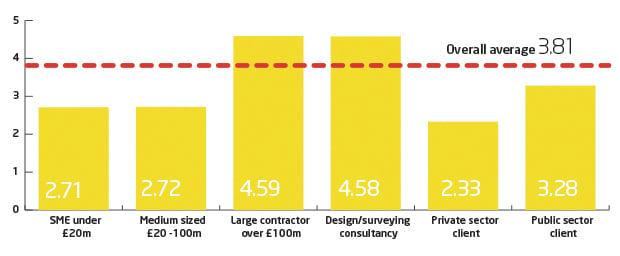
Speller Metcalfe is implementing BIM at the Habberley Learning Campus at Wyre Forest special school
The industry is struggling to get up to speed on Level 2 BIM, with respondents to the CM BIM survey rating their theoretical preparedness to implement BIM at just 3.81 on a scale of one to 10.
Sluggish progress – and emerging evidence of an adoption gap between SME contractors and large contractors – is evident in responses to the CM Level 2 BIM Readiness survey, completed by 246 individuals representing a cross section of the contractor, client and consultant communities.
For full details of the respondents and further analysis, see our feature here.
Asked how prepared they would be to implement Level 2 BIM on a project going on site in 2014, SME contractors turning over less than £20m and medium-sized contractors turning over £20m-£100m rated themselves at 2.71 and 2.72 respectively.
However, large contractors turning over £100m plus and design or surveying consultancies were far more confident, rating themselves at 4.59 and 4.58 respectively.
If you had to implement BIM in 2014 how prepared would you feel? (on a scale of 1-10)

The survey also showed that BIM is becoming more widespread, with 36 out of the 246 respondents saying they had worked on a project that met a Level 2 BIM specification, and a further 77 had worked on a project that displayed some elements of BIM.
Of the 18 public sector clients that responded to this question, nine had no experience of BIM, but encouragingly the same number did report that they were working on BIM projects.
But the survey also found that optimism over the better project outcomes promised by BIM was counter-balanced by fears from some respondents that it would tilt the market against them.
While 46.6% of the sample were confident that BIM would increase their opportunities to win work, 14% of respondents felt it would shrink their market.
Likewise, 41.6% thought that BIM would increase productivity and reduce costs, but 33.1% were also concerned that getting up to speed on BIM would decrease productivity and increase costs.
Better cohesion and collaboration within the supply chain was anticipated by 48.3%, but 23% were worried that BIM would create additional areas of conflict with clients and supply chain partners.
What impact do you think BIM will have on your business, taking a medium term view over the next 24 months?

The percentage of respondents rating their knowledge of key Level 2 BIM concepts as “poor” was also high: 53% confessed to a poor knowledge of the BIM project definitions in PAS 1192:2, 68.5% were unfamiliar with Employers Information Requirements, 55.5% were struggling to get to grips with COBie and 56.7% said they had a poor knowledge of the CIC BIM protocol.
The 22 public sector clients in the survey seemed to be no more clued up on these key concepts than the industry at large: 47% claimed a poor knowledge of PAS 1192:2, 52.6% said the same about EIRs, and COBie is poorly grasped by 52.6%.
In fact, when industry professionals currently delivering BIM spoke to CM, public sector clients’ lack of preparedness – and lack of enthusiasm for COBie – was a clear theme.
At Midlands contractor Speller Metcalfe, director Adrian Speller says he has recently seen tenders for MOD work where “BIM is specified but the specification is fairly vague, it doesn’t define the level of BIM and it doesn’t specify COBie”.
Speller feels that part of the problem is the lack of off-the-shelf contracts that allow public sector clients to set up a BIM-compliant project from day one. “There’s still a way to go before, as an industry, we develop a form of contract that supports BIM right from the feasibility stage,” he said.
At Balfour Beatty Construction Services, BIM director Peter Trebilcock says the company is currently delivering over 50 projects in BIM, but only has one current signed contract where the client requires COBie outputs. However, it also has 12 live tenders where COBie is required.
“It’s a step change for the industry to manage and capture all that data. It will need specialist training and the injection of some specialist people to make sure we meet our contractual requirements… But it’s certainly true that a large part of the team is not ready to provide data in COBie,” said Trebilcock.
He also speculates that some public sector clients post-2016 could specify “full PAS 1192:2 compliance” while others may define BIM differently.
But there is little suggestion that private sector clients are further along the road to BIM adoption. Rod McLennan MCIOB, a lecturer at Aberdeen’s Robert Gordon University, says that private clients often just want to get on site as quickly as possible. “As the green shoots are beginning to show…there’s a pressure to be first on site and to get the business. It’s a fantastic idea to have the time to work together [to develop the BIM model]at the start of the project, but that’s just not the reality.”
Comments
Comments are closed.












if you know me Richard, you will know that I am not a fan of these high-level terms. But as I also say, if it’s not clear or its being used incorrectly, get rid of it and say what you mean by not using these terms.
IF you or your client has decided to use these terms in your contracts and plans then the fault is on you if they are not clear.
These are just anchor terms to convey the standard. It’s for those that read and articulate the standard on behalf of their organizations and projects and its their job to resolve the issue around how these anchor terms are interpreted and then decide to either adopt these terms or stick to your own. if they are unclear, its your job to fix them. If your contract isn’t clear who is doing what because you decided to use Lead Appointed Party, then you have failed to clarify. The ISO absolutely does not state you have to incorporate these terms into your project plans or even your organisation. For example, I absolutely do not adopt all these terms in my organisation any more than I did with 1192.
Its no different to the other terms like BIM and CDE. if you place into your contract “We will use XYZ as our CDE solution” rather than just saying “All project information between ORG-A and ORG-B shall use XYZ and follow the process defined in the project management plan” then you have decided to adopt anchor terminology to do the talking for you rather than just saying what you mean. This leaves it open to interpretation.
I always say organisations and projects should not be following ISO19650. Organisations should articulate ISO19650, and then using the ISO9001 principles (as inc in 19650), translate this into their governance and then organisations and projects follow those business governances.
If part of that process has been you have decided to adopt all these anchor terms, but not ratified the definition, then there has been a gross error in uptake.
I appreciate you’re speaking from a UK perspective Richard, but there is someone else like you complaining about the exact same thing within their own country. For example, in the USA, they use the term ‘Owner’, not Client, and very few countries use ‘Employer’. Hence, terms like Appointing Party defined within the ISO 19650 series reflect the consensus of the ISO working group. The way around this is issue is the use of a National Foreword. If you take a look at BS EN ISO 19650-1’s National Foreword, you will see that the terms you are referring to have been mapped to the UK equivalent terms (as best we could). Each country is actively encouraged to the same. When aligning with the ISO 19650 series in the UK, you are therefore able to reference the UK equivalent terms in the documentation and contracts – you’re just not permitted to change the definition, but can add clarification if required. That said, I still don’t think this will resolve the issue as the ‘reality of roles in construction contracting’ is that they are pretty much inconsistent across each form of contract.
Methinks everyone doth protest too much.
Ever since the start of UK BIM in 2011, the language and terminology has always been a barrier to implementation.
I can imagine the response to asking a bricklayer to look at her TIDP!
How many terms does the Bond Bryan Dictionary run to these days? I rest my case.
Exeunt stage left – weeping and gnashing of teeth.
The term “Appointing Party” did not exist at ISO level before being invented by the authoring team of ISO 19650 and provides only two results from the ISO online browsing platform, Terms and Definitions both relating to ISO 19650.
The term “Client” provides some 299 number ISO results from the same platform, including ISO 6707-2 Buildings and civil engineering works — Vocabulary — Part 2: Contract and communication terms.
The term “Employer” similarly provides some 20 results within ISO standards of which 12 of these references are provided by ISO/TC 59, the same Technical committee that ISO 19650 sits under.
It is therefore somewhat ironic that the ISO 19650 series has turned information management from a standard for collaboration into a silo that exists outside of the confines of normal Design and Construction. The question to ask is why does ISO 19650 not conform to standard ISO terminology?
However, lets not get deflected by the terms and definitions issue. What is more worrying is the UK BIM Framework interpretation within the guidance created with multiple Lead Appointed Parties and the consequence of chaos prevailing, as outlined by Richard in this article. Richard is not alone in recognizing the possible consequences of the UK BIM Framework approach, but should be commended for raising this.
ISO 19650-1 clearly demonstrates within figure 8 a single Lead Appointed Party per stage and this is consistent across the ISO 19650 standards. The adoption method being proposed in other parts of the world follows the UK PAS 1192-2 approach with the requirements for a single Lead Consultant or Design Lead and the benefits this brings to a collaborative environment. Clarity of ownership and clear lines of responsibility are a must if we are to improve the way the industry works.